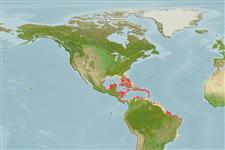Common names from other countries
>
Eupercaria/misc (Various families in series Eupercaria) >
Haemulidae (Grunts) > Haemulinae
Etymology: Haemulon: Greek, haimaleos = bloody (Ref. 45335).
More on author: Shaw.
Environment: milieu / climate zone / depth range / distribution range
Ecología
marino asociado a arrecife; rango de profundidad 0 - 30 m (Ref. 9626), usually 0 - 20 m (Ref. 9626). Subtropical; 33°N - 19°S, 98°W - 34°W
Western Atlantic: Florida, USA to Brazil, including the Gulf of Mexico and the Caribbean Sea.
Length at first maturity / Tamaño / Peso / Age
Maturity: Lm 18.5, range 14 - ? cm
Max length : 46.0 cm TL macho / no sexado; (Ref. 26340); common length : 25.0 cm TL macho / no sexado; (Ref. 3798); peso máximo publicado: 750.00 g (Ref. 5217); edad máxima reportada: 12 años (Ref. 72479)
Espinas dorsales (total) : 12; Radios blandos dorsales (total) : 16 - 17; Espinas anales: 3; Radios blandos anales: 9. Head and body yellow with narrow blue stripes continuing along length of body; stripe under eye with distinctive arch. Spiny dorsal fin yellow; soft dorsal and caudal fins blackish; anal fin dusky yellow (Ref. 26938). Scale rows below lateral line slightly oblique, yellow with blue stripes (Ref. 13442).
Found in small groups over coral and rocky reefs and drop-offs (Ref. 9710). Juveniles are abundant in Thalassia beds (Ref. 5217). Feeds on crustaceans, bivalves, and occasionally on small fishes. Marketed fresh.
Oviparous, distinct pairing during breeding (Ref. 205).
Courtenay, W.R. and H.F. Sahlman, 1978. Pomadasyidae. In W. Fischer (ed.) FAO species identification sheets for fishery purposes. Western Central Atlantic (Fishing Area 31), Volume 4. FAO, Rome. (Ref. 3798)
IUCN Red List Status (Ref. 130435)
CITES (Ref. 128078)
Not Evaluated
Threat to humans
Reports of ciguatera poisoning (Ref. 30303)
Human uses
Pesquerías: escaso valor comercial; Acuario: Acuarios públicos
Herramientas
Special reports
Download XML
Fuentes de Internet
Estimates based on models
Preferred temperature (Ref.
115969): 25.5 - 28, mean 27.3 (based on 280 cells).
Phylogenetic diversity index (Ref.
82804): PD
50 = 0.5000 [Uniqueness, from 0.5 = low to 2.0 = high].
Bayesian length-weight: a=0.01514 (0.01212 - 0.01890), b=2.99 (2.95 - 3.03), in cm Total Length, based on LWR estimates for this species (Ref.
93245).
Nivel trófico (Ref.
69278): 3.5 ±0.2 se; based on diet studies.
Resiliencia (Ref.
120179): Medio, población duplicada en un tiempo mínimo de 1.4-4.4 años (K=0.22-0.30; tm=2; Fec=47,000).
Fishing Vulnerability (Ref.
59153): Moderate vulnerability (35 of 100).
